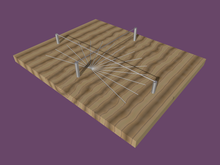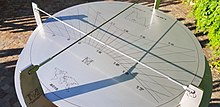Bifilar sundial
A bifilar dial is a type of sundial invented by the German mathematician Hugo Michnik in 1922.
It has two non-touching threads parallel to the dial.
Usually the second thread is orthogonal-(perpendicular) to the first.
[1] The intersection of the two threads' shadows gives the local apparent time.
When the threads have the correctly calculated separation, the hour-lines on the horizontal surface are uniformly drawn.
The angle between successive hour-lines is constant.
The bifilar dial was invented in April 1922 by the mathematician and maths teacher, Hugo Michnik, from Beuthen, Upper Silesia.
He studied the horizontal dial- starting on a conventional XYZ cartesian framework and building up a general projection which he states was an exceptional case of a Steiner transformation.
He related the trace of the sun to conic sections and the angle on the dial-plate to the hour angle and the calculation of local apparent time, using conventional hours and the historic Italian and Babylonian hours.
[1] He refers in the paper, to a previous publication on the theory of sundials in 1914.
Work has been subsequently done by Dominique Collin.
[3] This was the dial that Hugo Michnik invented and studied.
By simplifying the general example so: the shadow is thrown on a dial-plate marked out like a simple equatorial sundial.
is orientated north-south at a constant distance
(pronounced phi) is the latitude of the dial plate.
is the point on the dial plate directly under the two wires' intersection.
That point is the origin of the X,Y co-ordinate system referred to below.
One can show that if the position of the sun is known and determined by the spherical coordinates
(pronounced t-dot and delta, respectively the known as the hour angle et declination), the co-ordinates
, the equation of the trace of the sun associated with the local apparent time.
In its simplest form this equation is written: This relation shows that the hour traces are indeed line segments and the meeting-point of these line segments is the point
such : then the equation for the hour lines can be simply written as: at all times, the intersection
So provided the sundial respects the la condition
the trace of the sun corresponds to the hour-angle shown by lines (rays) centred on the point
and the 13 rays that correspond to the hours 6:00, 7:00, 8:00, 9:00... 15:00, 16:00, 17:00, 18:00 are regularly spaced at a constant angle of 15°, about point C. [a][1] A London dial is the name given to dials set for 51° 30' N. A simple London bifilar dial has a dial plate with 13 line segments drawn outward from a centre-point C, with each hour's line drawn 15° clockwise from the previous hour's line.
The midday line is aligned towards the north.
) centimeters- equivalent to 10 cm x sin(51° 30').
Whether a sundial is a bifilar, or whether it's the familiar flat-dial with a straight style (like the usual horizontal and vertical-declining sundials), making it reclining, vertical-declining, or reclining-declining is exactly the same.
The declining or reclining-declining mounting is achieved in exactly the same manner, whether the dial is bifilar, or the usual straight-style flat dial.
For any flat-dial, whether bifilar, or ordinary straight-style, the north celestial pole has a certain altitude, measured from the plane of the dial.


